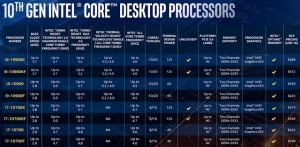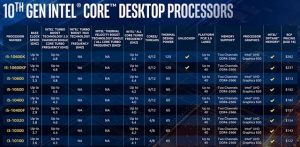Based on the ‘Skylake’ microarchitecture and built on Intel’s 14++nm process, the 10th-generation Comet Lake processor series includes 32 different SKUs divided between Intel Core i9, Core i7, Core i5, Core i3, Pentium Gold and Celeron processors. Intel also introduces Turbo Boost Max 3.0 and Thermal Velocity Boost (TVB) technology with the new 10th-gen, but they are limited only to the Core-i9 and Core-i7 CPU options. According to Intel, its flagship Intel Core i9-10900K is the “world’s fastest gaming processor” with 10 cores and 20 threads and offers speed with a base clock of 3.8 GHz and single-core turbo speeds of up to 5.3GHz under TVB (Thermal Velocity Boost) technology making it the highest clocked stock processor in the market. It is also equipped with a TDP of 125 watts but has a turbo power recommendation of 250W.
In its release, Intel states that the i9-10900K allows the following:
Up to 187 frames per second (fps) for in-game performance while streaming and recording, and up to 63% more frames per second in gaming compared with a 3-year-old PC. Up to 12% faster video editing compared with the previous generation, and up to 15% faster video editing compared with a 3-year-old PC. Up 18% faster 4K video editing compared with the previous generation, and up to 35% faster 4K video editing compared with a 3-year-old PC. Up to 31% better overall system performance compared with a 3-year-old PC.
Further, the Core i7 line-up comes with eight cores and 16 threads along with a base clock of 3.8 GHz and a maximum boost 5.1 GHz, with the all-core frequency max topping out at 4.7 GHz. The Core i5 processors have six cores and 12 threads, with a base speed of 4.1 GHz and a maximum boost of 4.8 GHz, an all-core 4.5 GHz. Also, the Core i3 CPUs come with four cores and eight threads along with a base clock of 3.8 GHz and a maximum boost of 4.6 GHz. The Core i9 and i7 chips all support dual-channel DDR4-2933 RAM except Celeron and Gold processors which support up to DDR4 2666 RAM. Certain models like the Core i9-10900 comes with a K in the suffix which means they are unlocked, while the ones with an F as a suffix means it has no (active) integrated GPU and has a lower price tag. All processors will have Intel UHD Graphics 630 except the F variants and will support 40 PCIe 3.0 lanes from the platform. The Pentiums and Celerons are all dual-core parts. While the Pentium chips are hyper-threaded (2-core, 4-threads), the Celerons (2-cores, 2-threads) do not have that feature. In addition, Intel is also offering Hyper-Threading technology across the 10th generation Core i9 to Core i3 processors. The new Intel processors come with enhanced core and memory overclocking and support for Intel Ethernet Connection I225 as well as Intel Wi-Fi 6 AX201 Gig+ for better connectivity and support up to 40 platform PCIe lanes. “Intel is committed to enabling the future of powerful desktop gaming by continuously pushing the performance boundary to deliver an amazing PC gaming experience,” said Brandt Guttridge, Intel senior director of the Desktop Products Group. The top-tier Core i9-10900K will be available for $488, the i7-10700K for $374, and the i5-10600K will cost $262. However, the Core i9-10900KF will cost $472, the i7-10700KF will cost $349 and the i5-10600KF will cost $237. Further, the Core i3-10320 will be priced at $154 and the i3-10100 at $122.

